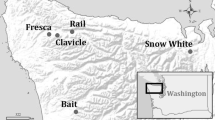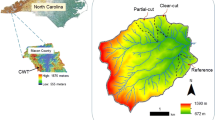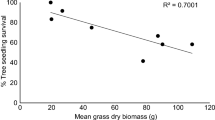Abstract
Thirty-five years post-harvest, effects of harvest disturbances upon tree composition and aboveground biomass were evaluated in a water-tupelo (Nyssa aquatica)- baldcypress (Taxodium distichum) bottomland. The forested wetland, along the Tensaw River, is within the Mobile-Tensaw River Delta in southwest Alabama. Nine replications of four disturbances were evaluated: no harvest reference (REF), clearcutting with helicopter removal (HELI), HELI combined with skidder extraction simulation (SKID), and HELI combined with broadcast herbicide application (glyphosate) to sprouts and seedlings for two years (GLYPH). Thirty-five years post-treatment, species, diameter at breast height (DBH; 1.37 m or above swell) and tree height were measured within treatments and converted to aboveground dry weight biomass. Clip plots were installed for herbaceous and woody stems < 1.37 m. Density and biomass results indicate HELI and SKID are on a trajectory to produce species, densities and biomass similar to REF. GLYPH coppice and seedlings were removed, so GLYPH regenerated from seedbanks and flood disseminated seed. GLYPH has transitioned from an herbaceous freshwater marsh to an open woodland/savanna community. GLYPH exemplifies advantages of coppice for rapid tree regeneration and growth on sites with long hydroperiods. This research demonstrates the capacity for long-term recovery of forested wetland ecosystems following harvest where multiple site/stand factors favored recovery. Adequate stocking of flood tolerant species capable of stump sprouting favored survival of original species. Floods provided annual sediment deposits to offset rutting. Compaction was additionally ameliorated by shrink-swell clays. Finally, nearby forests provided seed sources for areas. Collectively, these factors favored rapid recovery from disturbances.
Similar content being viewed by others
Data Availability
The datasets from the current study are available from the corresponding author upon reasonable request.
Abbreviations
- REF:
-
No harvest reference
- HELI:
-
Clearcutting with helicopter removal
- SKID:
-
Skidder extraction simulation
- GLYPH:
-
Broadcast spray (glyphosate) of sprouts and seedlings for two years
- DBH:
-
Diameter at breast height
- BMP:
-
Best management practice
- MTRD:
-
Mobile-Tensaw River Delta
References
Abrahamson LP, Harper JD (1973) Microbial insecticides control forest tent caterpillar in southwestern Alabama. USDA Forest Service Southern Forest Experiment Station, New Orleans, LA, Research Note SO-157. 4
Anderson CJ, Lockaby BG (2011) The effectiveness of forestry best management practices for sediment control in the southeastern United States: A literature review. South J Appl for 35:170–177
Aust WM, Blinn CR (2004) Forestry best management practices for timber harvesting and site preparation in the eastern United States: An overview of water quality and productivity research during the past 20 years (1982–2002). Water, Air, & Soil Pollution: Focus 4:5–36. https://doi.org/10.1023/B:WAFO.0000012828.33069.f6
Aust WM, Lea R (1991) Site temperature and organic matter in a disturbed forested wetland. Soil Sci Soc Amer J 55(6):1741–1746
Aust WM, Lea R (1992) Comparative effects of aerial and ground logging on soil properties in a tupelo-cypress wetland. For Ecol Manage 50:57–73
Aust WM, Mader SF, Mitchell LJ, Lea R (1990) An approach to the inventory of forested wetlands for timber harvest impact assessment. For Ecol Manage 33(34):215–225
Aust WM, Lea R, Gregory JD (1991) Removal of floodwater sediments by a clearcut tupelo-cypress wetland. Water Resour Bull 27(1):111–116
Aust WM, Tippett MD, Burger JA, McKee WH (1995) Compaction and rutting during harvesting affect better drained soils more than poorly drained soils on wet pine flats. South J Appl for 18:72–77
Aust WM, Schoenholtz SH, Zaebst TW, Szabo BA (1997) Recovery status of a tupelo-cypress wetlands after disturbance: Silvicultural implications. For Ecol Manage 2(3):161–169. https://doi.org/10.1016/S0378-1127(96)03899-6
Aust W, Fristoe T, Gellerstedt P, Giese L, Miwa M (2006) Long-term effects of helicopter and ground-based skidding on site properties and stand growth in a tupelo-cypress wetland. For Ecol Manage 226:72–79. https://doi.org/10.1016/j.foreco.2005.12.059
Aust WM, McKee SE, Seiler JR, Strahm BD, Schilling EB (2012) Long-term sediment accretion in bottomland hardwoods following timber harvest disturbances in the Mobile-Tensaw River Delta, Alabama, USA. Wetlands 32:871–884
Aust W, Bolding M, Barrett S (2020) Silviculture in Forested wetlands: Summary of current forest operations, potential effects, and long-term experiments. Wetlands 40:21–36. https://doi.org/10.1007/s13157-019-01191-6
Aust WM, Schoenholtz SH, Miwa M, Fristoe TC (1998) Growth and development of water tupelo (Nyssa aquatica)-baldcypress (Taxodium distichum) following helicopter and skidder harvesting: Ten-year results. In: Waldrop TA (ed) Proceedings of the Ninth Biennial Southern Silvicultural Research Conference, 1997 February 25–27, Clemson, SC. Gen. Tech. Rep. SRS–20. Asheville, NC: USDA Forest Service, Southern Research Station: 363–367
Aust WM (1989) Abiotic functional changes of a water tupelo – baldcypress wetland following disturbance by harvesting. Dissertation, North Carolina State University
Aust WM (1994) Best management practices for forested wetlands in the southern Appalachian region. In: Trettin CC, Aust WM, Wisniewski J (eds) Wetlands of the Interior Southeastern United States. Springer, Dordrecht. https://doi.org/10.1007/978-94-011-6579-2_16
Bowling DR, Kellison RC (1983) Bottomland hardwood stand development following clearcutting. South J Appl for 7(3):110–116
Busbee SW, Conner WH, Allen DM, Lanham JD (2003) Composition and aboveground productivity of three seasonally flooded depressional forested wetlands in coastal South Carolina. Southeastern Naturalist 2:335–346
Cambi M, Certini G, Francesco N, Enrico N (2015) The impact of heavy traffic on forest soils: a review. For Ecol Manage 338:124–138
Clark A, Phillips DR, Frederick DJ (1985) Weight, volume, and physical properties of major hardwood species in the Gulf and Atlantic coastal plains. USDA Forest Service Southeastern Forest Expt. Stat. Research Paper SE-250. pp. 72
Conner WH, Gosselink J (1981) Comparison of the vegetation of three Louisiana swamp sites with differing flooding regimes. Am J Bot 68(3):32–331
Curtis WF, Culbertson JK, Chase EB (1973) Fluvial-sediment discharge to the oceans from the conterminous United States. Geological Survey Circular 670. US Geological Survey, Washington, DC
Dahl TE, Allord GJ (1996) History of wetlands in the conterminous United States. In: Fretwell JD, Williams JS, Redman PJ (eds) National water summary on wetland resources. Water-Supply Paper 2425, US Geological Survey, Reston VA. pp. 19–26
Dahl T (2006) Wetlands Losses in the United States 1780's to 1980's, US Environmental Protection Agency. https://policycommons.net/artifacts/2396542/wetlands-losses-in-the-united-states-1780s-to-1980s/3418070/. Retrieved 22 Jun 2022. CID: 20.500.12592/6r1546
Davidson NC (2014) How much wetland has the world lost? Long-term and recent trends in global wetland area. Marine Freshwater Res 65:934–941. https://doi.org/10.1071/MF14173
DeArmond D, Ferraz JBS, Higuchi N (2021) Natural recovery of skid trails: a review. Can J for Res 51:948–961
Dicke SG, Toliver JR (1990) Growth and development of bald-cypress/water-tupelo stands under continuous versus seasonal flooding. For Ecol Manage 33(34):523–530
Edwards BL, Allen ST, Braud DH, Keim RF (2019) Stand density and carbon storage in cypress-tupelo wetland forests of the Mississippi River delta. For Ecol Manage 441:106–104
Faulkner SP, Patrick WH Jr (1992) Redox processes and diagnostic wetland soil indicators in bottomland hardwood forests. Soil Sci Soc Am J 56(3):856–865. https://doi.org/10.2136/sssaj1992.03615995005600030030x
Gellerstedt P, Aust WM (2004) Timber harvesting effects after 16 years in a tupelo-cypress swamp. p. 524–527. Proc 12th Biennial Southern Silvicultural Research Conference, Biloxi, MS, Feb. 24–28, 2003. USDA Forest Service Gen. Techn. Rep. SRS-71. p. 594
Gellerstedt P, Aust WM, Warren S (2002) Fifteen-year patterns of sediment removal by a riparian wetland as influenced by harvesting. p. 27. Forestry Best Management Practices Research Symposium, Atlanta, GA, April 15–17. National Council for Air and Stream Improvement
Goutal N, Keller TK, Defossez P, Ranger J (2013) Soil compaction due to heavy forest traffic: measurements and simulations using an analytical soil compaction model. Annals for Sci 70:545–556
Granger JJ, Zobel JM, Buckley DS (2020) Differential impacts of emerald ash borer (Agrilis planipennis Fairmaire) on forest communities containing native ash (Fraxinus spp.) species in eastern North America. For Sci 66(1):38–48
Greacen EL, Sands R (1980) Compaction of forest soils: a review. Austral J Soil Res 18:163–189
Herms DA, McCullough DG (2014) Emerald ash borer invasion of North America: History, biology, ecology, impacts, and management. Annu Rev Entomol 59:13–30
Hodges JD (1994) The southern bottomland hardwood region and brown loam bluffs subregion. In: Barrett JW (ed) Regional silviculture of the United States, 3rd edn. Wiley, NY, pp 227–267
Hodges JD (1997) Development and ecology of bottomland hardwood sites. For Ecol Manage 90:117–125
Hodges JD (1993) Ecology of Bottomland Hardwoods. Workshop to Resolve Conflicts in the Conservation of Migratory Landbirds in Bottomland Hardwood Forest. Aug 9–10, Tallulah, LA. 5–11
Horn R, Vossbrink J, Becker S (2004) Modern forestry vehicles and their impacts on soil physical properties. Soil Tillage Res 79:207–219
Hotvedt JE, Coa QV, Parresol BR (1985) Tree-volume and stem profile functions for baldcypress. South J Appl for 9(4):227–232
Hu S, Niu Z, Chen Y, Li L, Zhang H (2017) Global wetlands: potential distribution, wetland loss, and status. Sci Total Environ 686:319–327. https://doi.org/10.1016/j.scitotenv.2017.02.001
Hunter RG, Faulkner SP, Gibson KA (2008) The importance of hydrology in restoration of bottomland hardwood wetland functions. Wetlands 28:605–615
Hupp C (2000) Hydrology, geomorphology and vegetation of Coastal Plain rivers in the south-eastern USA. Hydrol Processes 14:2991–3010
Hutchens JJ, Batzer DP, Reese E (2004) Bioassment of silvicultural impacts in stream and wetlands of the eastern United States. Water, Air, Soil Pollution: Focus 4:37–53
Jenkins JC, Chojnacky DC, Heath LS, Birdsey RA (2003) National scale biomass estimators for United States tree species. For Sci 49:12–35
Johnson RL, Shropshire FW (1983) Bottomland hardwoods. In: Burns RM (ed) Silviculture systems for the major forest types of the United States. USDA Forest Service Agricultural Handbook 455 (revised), Washington DC, pp 474–478
Kellison R, Young M (1997) The bottomland hardwood forest of the southern United States. For Ecol Manage 90:101–115
Kidd KR, Copenheaver CA, Aust WM (2015) Sediment accretion rates for natural levee and backswamp riparian forests in the Mobile-Tensaw bottomlands, Alabama. For Ecol Manage 358:271–280
King SL, Keim RF (2019) Hydrologic modifications challenge bottomland hardwood forest management. J for 117:504–514
Labelle ER, Hansson L, Hogbom L, Jourgholami M, Laschi L (2022) Strategies to mitigate the effects of soil physical disturbances caused by forest machinery: a comprehensive review. Current for Rep. https://doi.org/10.1007/s40725-021-00155-6
Lockaby BG, Jones RH, Clawson RG, Meadows JS, Stanturf JA, Thornton FC (1997a) Influences of harvesting on functions of floodplain forest associated with low-order, blackwater streams. For Ecol Manage 90:217–224
Lockaby BG, Stanturf JA, Messina MG (1997b) Effects of silvicultural activity on ecological processes in floodplain forest of the southern United States: a review of existing reports. For Ecol Manage 90:93–100
Ludwig RF, McLaughlin DL, Wurster FC (2021) Red maple dominance and community homogenization in a disturbed forested wetland. Wetlands Ecol Manage 29:599–615
Mader SF, Aust WM, Lea R (1989a) Changes in functional values of a forested wetland following timber harvesting practices. In: Hook DD, Lea R (eds.) Proceedings of the Symposium: The Forested Wetlands of the Southern United States. USDA Forest Service General Technical Report SE-50, Asheville, NC. https://doi.org/10.2737/SE-GTR-50
Mader SF, Aust WM, Lea R (1989b). Changes in net primary productivity and cellulose decomposition rates in a water tupelo-baldcypress swamp following timber harvest. Proceedings of the Fifth Southern Silvicultural Research Conference, Memphis, TN. USDA Forest Service General Technical Report SO-74, pp. 539–543
Mader SF (1990) Recovery of ecosystem functions and plant community structure by a tupelo-cypress wetland following timber harvesting. Dissertation, North Carolina State University
McEachran ZP, Karwan DL, Slesak RA (2021) Direct and indirect effects of forest harvesting on sediment yield in forested watershesd of the United States. J Amer Water Resour Assoc 57:1–31
McKee WH, Hatchell GE, Tiarks AE (1985) Managing site damage from logging: a loblolly pine management guide. USDA Forest Service, Southeastern Forest Experiment Station, Gen Tech Rep SE 32:21p
McKee S, Aust W, Seiler J, Strahm B, Schilling E (2012) Long-term site productivity of a tupelo-cypress swamp 24 years after harvesting disturbances. For Ecol Manage 265:172–180
McKee S, Seiler J, Aust W, Strahm B, Schilling E, Brooks S (2013) Carbon pools and fluxes in a tupelo (Nyssa aquatica)-baldcypress (Taxodium distichum) swamp 24 years after harvest disturbances. Biomass Bioenergy 55:130–140
Meadows J, Stanturf J (1997) Silvicultural systems for southern bottomland hardwood forests. For Ecol Manage 90:127–140
Messina MG, Schoenholtz SH, Lowe MW, Wang Z, Gunter DK, Londo AJ (1997) Initial responses of woody vegetation, water quality, and soils to harvesting intensity in a Texas bottomland hardwood ecosystem. For Ecol Manage 90(2–3):201–215
Mitsch WJ, Bernal B, Hernandez ME (2015) Ecosystem services of wetlands. Int J Biodiv Sci, Ecosyst Serv Manage 1:1–4. https://doi.org/10.1080/21513732.2015.1006250
Miwa M, Aust WM, Burger JA, Patterson SC, Carter EA (2004) Wet-weather timber harvesting and site preparation effects on coastal plain sites: a review. South J Appl for 28(3):137–151
Muzika RM, Gladden JB, Haddock JD (1987) Structural and functional aspects of succession in southeastern floodplain forests following a major disturbance. Am Midland Naturalist 117:1–9
Perison D, Phelps J, Pavel C, Kellison R (1997) The effects of timber harvest in a South Carolina blackwater bottomlands. For Ecol Manage 90:171–185
Picchio R, Jourgholami M, Zenner EK (2021) Effects of forest harvesting on water and sediment yields: a review toward better mitigation and rehabilitation strategies. Curr Forestry Rep 7:214–229. https://doi.org/10.1007/s40725-021-00146-7
Putz FE, Sist P, Fredericksen T, Dykstra D (2008) Reduced-impact logging: challenges and opportunities. For Ecol Manage 256:1427–1433
Rapp J, Shear T, Robison D (2001) Soil, groundwater and floristics of a southeastern United States blackwater swamp 8 years after clearcutting with helicopter and skidder extraction of the timber. For Ecol Manage 149(1–3):241–252
Riccio JF, Hardin JD, Lamb GM (1973) Development of hydrologic concept for the greater mobile metropolitan-urban environment. Geological Survey of Alabama, Bulletin 106, Tuscaloosa, AL
Schilling E, Lang A, Nicholson H, Nettles J, Gerow T, McInnis D (2019) Evolving silvicultural practices to meet sustainability objectives in forested wetlands of the southeastern United States. Wetlands 40:37–46
Schneider RL, Sharitz RR (1988) Hydrochory and regeneration in a bald cypress-water tupelo swamp forest. Ecology: 1055–1063
Shoch DT, Kaster G, Hohl A, Souter R (2009) Carbon storage of bottomland hardwood afforestation in the lower Mississippi Valley, USA. Wetlands 29(2):535–542
Slye JN, Lang AJ, Gerow TA (2020) A limited rapid assessment of forest regeneration in 24 cypress and tupelo bottomland swamps following clearcutting and shovel logging in the coastal plain of North Carolina. Forests 11:854–869
Smith CG, Osterman LE, Poore RZ (2013) An examination of historical inorganic sediment and organic matter accumulation in several marsh types in Mobile Bay and Mobile-Tensaw Delta Region. J Coastal Res 63(10063):68–83
Spencer DR, Perry JA, Silberhorn GM (2001) Early secondary succession in bottomland hardwood forests of Southeastern Virginia. Environm Manage 27(4):559–570
Stokes B, Schilling A (1997) Improved harvesting systems for wet sites. For Ecol Manage 90:155–160
Sun G, McNulty SG, Shepard JP, Amatya DM, Riekerk H, Comerford NB, Skaggs W, Swift L Jr (2001) Effects of timber management on the hydrology of wetland forests in the southern United States. For Ecol Manage 143:227–236
Wigley T, Roberts T (1997) Landscape-level effects of forest management on faunal diversity in bottomland hardwoods. For Ecol Manage 90:141–154
Acknowledgements
Financial support for this research was provided by The National Council for Air and Stream Improvement, Inc. (NCASI) and the McIntire-Stennis program of the USDA National Institute of Food and Agriculture. Logistical support was provided by the Departments of Forest Resources and Environmental Conservation and Fish and Wildlife Conservation of the College of Natural Resources and Environment at Virginia Tech. Permission to access the site was provided by the State of Alabama.
Funding
This research received research support from the USDA National Institute of Food and Agriculture McIntire-Stennis Program, the National Council for Air and Stream Improvement (NCASI), and the Virginia Tech College of Natural Resources and Environment, Department of Forest Resources and Environmental Conservation.
Author information
Authors and Affiliations
Contributions
WMA was an original investigator for the previous portions of the study. WMA, DRC, and TAC designed the 35-year remeasurement and remeasurement. WMA, DRC, and CE collected the data on the site. CE drafted the original manuscript as part of her Master of Forestry program, and WMA, DRC, and TAC served as her graduate committee. The original draft was by WMA, DRC, TAC, and EBS. EBS oversaw the financial assistance from NCASI. All authors have read and approved the manuscript.
Corresponding author
Ethics declarations
Competing Interests
Drs. Aust, Coates, and Carter have received financial support for research from NCASI, and Dr. Schilling is employed by NCASI.
Additional information
Publisher's Note
Springer Nature remains neutral with regard to jurisdictional claims in published maps and institutional affiliations.
Rights and permissions
Springer Nature or its licensor (e.g. a society or other partner) holds exclusive rights to this article under a publishing agreement with the author(s) or other rightsholder(s); author self-archiving of the accepted manuscript version of this article is solely governed by the terms of such publishing agreement and applicable law.
About this article
Cite this article
Every, C., Aust, W.M., Carter, D.R. et al. Thirty-five-year timber harvesting disturbance effects on composition and biomass of tupelo-cypress (Nyssa-Taxodium) forested wetlands, southwest Alabama, USA. Wetlands 43, 106 (2023). https://doi.org/10.1007/s13157-023-01753-9
Received:
Accepted:
Published:
DOI: https://doi.org/10.1007/s13157-023-01753-9







